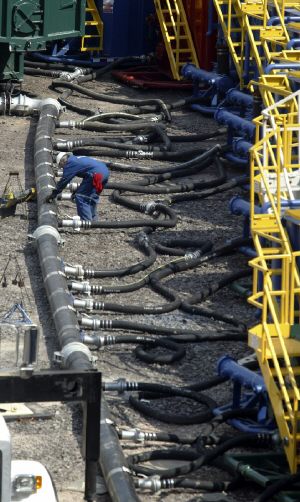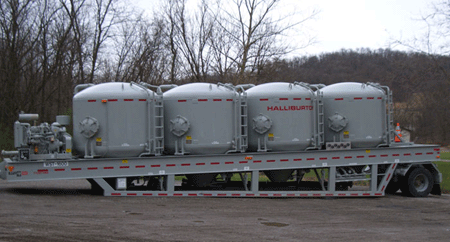Hydro-fracturing
From Wikimarcellus
Hydro-fracturing, (aka Hydraulic fracturing) or fracing for short, is the process of injecting water, sand, diesel fuel, and/or a cocktail of chemicals into a well, under high pressure, in order to fracture the shale thereby releasing methane gas trapped in the pores of the rock so it can flow up the pipe. It is a time tested procedure for stimulating a well’s productivity that has been used in oil and gas drilling since the 1940's.
Hydro-fracturing may be accompanied by acid fracturing and the use of proppants. Also crosslinked guar gel is sometimes used. Generally, drilling industry purveyors consider the exact recipes they use for preparing drilling fluids to be their trade secrets. This includes the chemicals involved. Several of these are believed to be toxic.

Worker adjusting water line used in hydro-fracturing
a Marcellus well in Dimock Township, Susquehanna County, PA
Courtesy of Michael J. Mullen, Staff Photographer,
Scranton Times-Tribune[1]
While the hydro-fracturing process can use millions of gallons of water for a well, typically a well uses around 750,000 gallons. It generates similar quantities of waste water. The fluid that comes back up after fracturing a shale well is called flowback water. It includes all of the chemicals pumped in plus both non-toxic and toxic substances that may be present in the shale formation. Water usually must be trucked into and out of a well site. One approach that can be used to minimize the amount of polluted water trucked out is a closed loop system.
One method of hydro-fracturing is called slickwater.

Halliburton frac fluid trailer
left along side highway near the Borough
of Houston, Washington County, PA
Photo credit - donnan.com
Many environmentalists have raised concerns about the process of hydro-fracturing shale wells as a potential source of toxic contamination of the water supply. Polluted water has also occasionally leaked from plastic-lined wastewater containment pits. Marcellus shale drilling is still more or less still in its infancy compared to drilling in other North American shales. To date there have been very few Marcellus water contamination issues with notable exceptions of Dimock and Cross Creek Park.
Protecting groundwater is considered by all responsible drillers to be part of their job. Carefully engineered well casings made from steel and special concrete maintain an effective barrier between the well bore and surrounding groundwater as it passes through. Hydro-fracturing takes place thousands of feet below the water table, so leakage of any contaminated water would certainly seem to be quite uncommon, if not the rare exception.
The process uses anywhere from 750,000 gallons of water on up to millions of gallons per well which usually must be trucked into drilling sites. The tanker trucks used to bring water in and diesel engines used to power drilling and pumping equipment on the drill site are recognized as a sources of air pollution. There are also concerns about noise-control issues. These relate not only to noise from drilling and pumping equipment, but also from gas compressors which run continuously once the well is actually producing gas.
Resources
Pennsylvania Department of Environmental Protection, Summary of Hydraulic Fracture Solutions-(PDF Format) [2]

